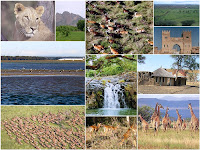Safari Notes: Liuwa Plains
 The wildebeests are back. "A dust storm of migrating wildebeests pounds through Zambia's Liuwa Plain National Park. Photographer Chris Johns calls the little-visited park a 'rival of the Serengeti...' is how the National Geographic magazine describes the sight in Zambia, back in 1997.
The wildebeests are back. "A dust storm of migrating wildebeests pounds through Zambia's Liuwa Plain National Park. Photographer Chris Johns calls the little-visited park a 'rival of the Serengeti...' is how the National Geographic magazine describes the sight in Zambia, back in 1997.Many may have heard of the Liuwa Plains, but very few tourists indeed, have been to the almost 3,700 square kilometers remote, vast national park - in Western Zambia. Though the plains has a variety of many birds and other animals, and a spectacular display of golden grassland - the biggest and most fascinating attraction is the awesome migration of wildebeests; blue wildebeests. Every year, running through November and December - the second largest wildebeest migration on earth of tens of thousands of wildebeests, cross over from Angola to Zambia. Only the wildebeest migration of the Masai Mara-Serengeti, offers a much more spectacular sight.
Due to the long civil war in Angola, many wildebeests and other animals were slaughtered. Many are still hunted now, but through the last few years, with peace in Angola and a much better supervised and protected Liuwa on the Zambian side - the number of wild animals has increased; including that of wildebeests. During the rainy season, and the floods, which begins in November, thousands of blue wildebeest, now said to number about 50,000, meet on the Plains. The herd moves along in a vast group, followed by predators looking to catch any stragglers that might stray from the main group.
The best times to visit Liuwa is during November-December and May-June. Due to its remoteness and the inaccessible nature of the Plains - very, very few tourists venture to Liuwa. For those who seek a real African safari, offering the very authentic and untouched of the continent, then the Liuwa Plains is one of those places. One of a very handful of such places still remaining in Africa.


